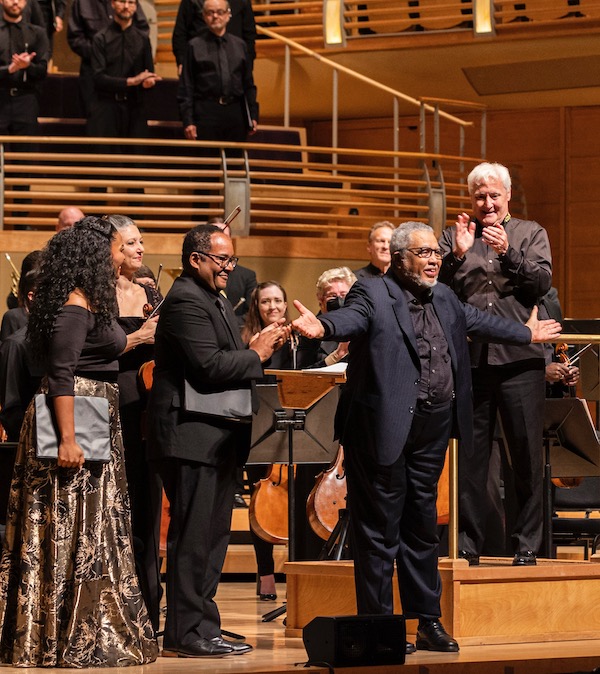National Philharmonic wraps season with stirring Hailstork premiere

Composer Adolphus Hailstork is applauded by conductor Piotr Gajewski and soloists Aundi Marie Moore and Norman Shankle following the world premiere of Hailstork’s Symphony No. 5 by the National Philharmonic Sunday at Strathmore Music Center. Photo: Elman Studio
For the final concert of its 2022-23 season, the National Philharmonic, led by music director Piotr Gajewski, presented a world premiere by Adolphus Hailstork Sunday afternoon at the Strathmore Music Center.
Last year, the orchestra gave a memorable premiere with the Washington Chorus of Hailkstork’s cantata America’s Requiem—A Knee on the Neck, composed in response to the murder of George Floyd. If that work showed Hailstork’s vision of what he thought America had become, the Symphony No. 5, which debuted Sunday, showed a vision of what America could be.
Born in Rochester and currently residing in Virginia Beach, Hailstork composed his Symphony No. 5 for soloists, chorus, and orchestra. The composer packs a lot into this 20-minute symphony. Bizarrely, the program notes for this concert included no description of the new work. The movement titles and some text lines for the vocal forces were the only clues to the journey.
The first movement, “Answering the Call,” began with eerie chimes and quiet rustles in the tambourine (played with delicacy and precision by Julie Choi), onto which Hailstork layered soft dissonances in the strings. As more instruments joined the music, little gestures repeated and accumulated to suggest a melody. The music soon took an unexpected turn into boisterous syncopated rhythms, with Choi using the tambourine to drive the dance, as glimmers of the hymn to come emerged.
“Vigil,” the second movement, returned to the eerie atmosphere that began the symphony, with whispery rumbles from the bass drum; eventually the double basses began a quiet rumination. The rest of the strings joined, and solos from the trumpet and the oboe again foreshadowed the hymn, but this movement ended on an unsteady harmonic progression, beautifully limned by the orchestra.
“Bound for the Promised Land” arrived in the third movement, triumphant in the voices of the National Philharmonic Chorale, soprano Aundi Marie Moore, and tenor Norman Shankle. The added verses left no doubt as to the nature of Hailstork’s promised land — one read “Thought we come from ev’ry race and land we share a common dream, a more perfect union to vouch safe to our posterity.”
Though it was sometimes difficult to hear the two soloists over the orchestra, Gajewski marshaled all his forces toward a stirring celebration. Yet, as satisfying as it was, this movement lacked the fascinating colors and sustained tension of the preceding two. It also felt abrupt; one wanted a more extended transformation before such a complete resolution.
Carl Orff’s hour-long Carmina Burana made up the balance of Sunday’s program. For a work filled with catchy tunes, infectious rhythms, and songs about drinking, lechery, and (in one case) the tribulations of a roast swan, the performance started tentatively. At times, the National Philharmonic Chorale seemed so intent on pushing out all the consonants in the medieval Latin and German texts that the melodic line occasionally fragmented, and the orchestra sometimes drowned them out.
But rich-voiced baritone Brandon Hendrickson introduced a welcome swagger and humor with his solos (particularly in the raging “Estuans interius” and the inebriated “Ego sum abbas”), Robert Baker made a hilarious cameo as the roast swan, singing in a purposefully pinched tenor, and gradually the performance found its groove.
“Tempus es iocundum” received rousing contributions from creamy-voiced soprano Danielle Talamantes and the Strathmore Children’s Chorus, and the closing “O Fortuna” was as loud and exciting as anyone could want.
The National Philharmonic opens its 2023-24 season October 14, with Michelle Cann performing George Gershwin’s Rhapsody in Blue and Florence Price’s Piano Concerto. nationalphilharmonic.org
